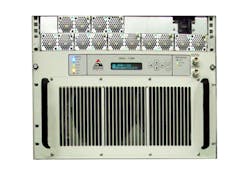Pulses provide target detection for a wide range of radar systems in military, industrial and, increasingly, in commercial automotive systems. The systems rely on working with pulses at suitable transmit power, which is usually provided by a pulsed high-frequency power amplifier (PA).
Such PAs were once almost entirely designed with traveling-wave tubes (TWTs) and vacuum-tube technology. More and more, however, solid-state PAs are working their ways into military radar systems as well as electronic warfare and electronic countermeasures (ECM) that require pulsed signals. While not always smaller or lighter than TWT amplifiers (TWTAs), SSPAs are cost-effective and reliable even in the most challenging operating environments.
The power transistors in pulsed SSPAs for military radar systems have traditionally been based on silicon (Si) substrate materials, such as Si bipolar transistors, Si MOSFETs, or Si LDMOS devices. At higher operating frequencies, transistors have been fabricated on different semiconductor materials, including GaAs. More recently, a pair of wide-bandgap (WBG) semiconductor substrates, gallium nitride (GaN) and silicon carbide (SiC), have served as starting points for the high-power transistors used in pulsed radar SSPAs. WBG substrate materials feature excellent thermal characteristics for reliable operation at high power levels, even in compact amplifier housings with minimal heat sinks.
For any SSPA intended for a radar application, several performance parameters can serve as guidelines for matching the component to an application, starting with frequency range. The output power will depend on pulse characteristics, such as the pulse width, and the duration that the pulse is in the “on state,” which is its percentage of duty cycle. SSPAs working with shorter pulse widths and pulse duty cycles will typically provide higher output power levels than amplifiers boosting longer pulse widths at longer duty cycles. In addition, SSPA gain is a measure of the level of input signal power that will be needed to reach the SSPA’s rated output power level.
An example of a pulsed SSPA based on GaN is the S-band APRA-S2500A from Advantech Wireless, which can be used from 2.7 to 2.9 GHz (see figure). It delivers as much as 2500 W over its 200-MHz bandwidth when fed with an input power level of 0 dBm. The SSPA operates with pulse widths from 0.1 to 100.0 µs and pulse duty cycles to 10%. It suffers minimal pulse distortion, with fast pulse rise/fall times of better than 100 ns and minimum pulse droop of 1% or better at 100-µs pulse width. The amplifier is equipped with input and output sample ports for monitoring signal quality and reliability.
The APRA-S2500A is a GaN-based S-band SSPA capable of 2500 W pulsed output power from 2.7 to 2.9 GHz. (Courtesy of Advantech Wireless)
The high power levels possible with GaN transistors has several companies developing GaN-based pulsed SSPAs as replacements for TWT amplifiers in radar systems. API Technologies is one of these firms, offering GaN-based pulsed SSPAs with output levels to 1 kW through 18 GHz.
HD Communications Corp.has developed pulsed SSPAs based on both Si LDMOS and GaN device technologies. For example, model HD32091 is a rack-mountable GaN-based SSPA with 10 kW peak output power from 1 to 2 GHz. Suitable for long pulsed L-band applications, the Class AB linear amplifier works with pulse widths from 4 to 650 µs at 15% maximum duty cycle. The rugged SSPA has built-in control, monitoring, and protection circuits.
For lower-power radar applications in smaller packages, the model TGA2307-SM packaged MMIC amplifier from Qorvo takes advantage of GaN’s high power density and SiC’s enhanced thermal characteristics, using a GaN-on-SiC semiconductor process. It produces 50 W output power at C-band frequencies from 5 to 6 GHz while operating with pulse width of 100 µs at 1% duty cycle. The SSPA, which comes in a 6- × 6-mm overmold QFN plastic package, can also be used in continuous-wave (CW) applications.
These SSPAs represent just a sampling of the growing number of semiconductor-based power amplifiers available for pulsed-radar applications, with additional suppliers including Empower RF Systems, Instruments for Industry, LCF Amplifiers, and Teledyne Defence & Space providing SSPAs at pulse output-power levels to 1 kW at frequencies to 18 GHz.
About the Author
Jack Browne
Technical Contributor
Jack Browne, Technical Contributor, has worked in technical publishing for over 30 years. He managed the content and production of three technical journals while at the American Institute of Physics, including Medical Physics and the Journal of Vacuum Science & Technology. He has been a Publisher and Editor for Penton Media, started the firm’s Wireless Symposium & Exhibition trade show in 1993, and currently serves as Technical Contributor for that company's Microwaves & RF magazine. Browne, who holds a BS in Mathematics from City College of New York and BA degrees in English and Philosophy from Fordham University, is a member of the IEEE.


